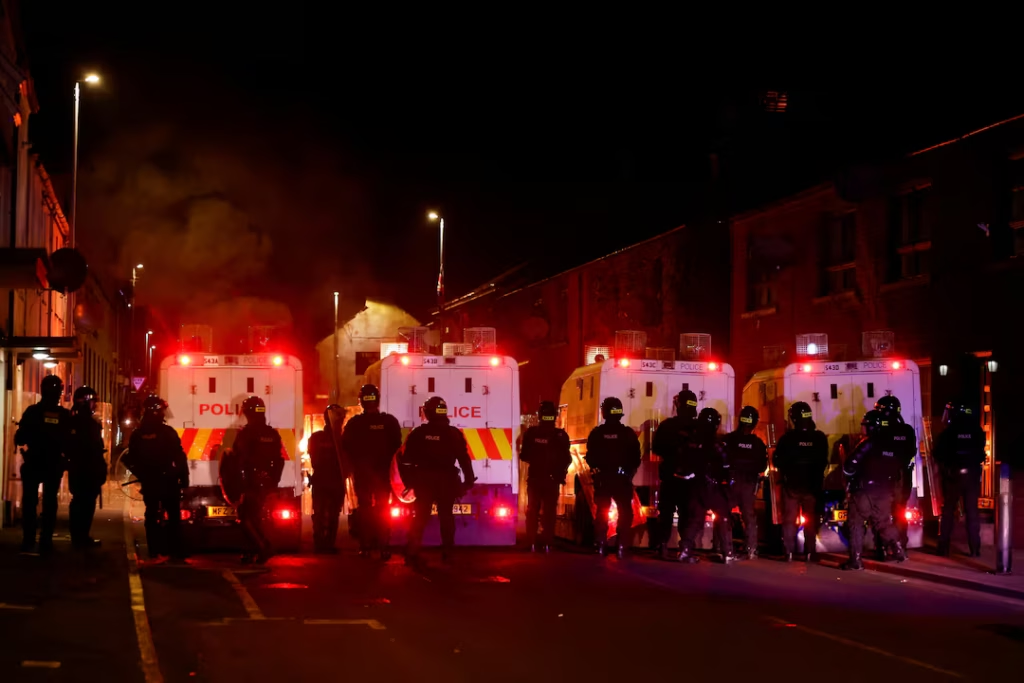BELFAST (BN24) — Authorities in Northern Ireland say residents of Ballymena are living in fear following a second consecutive night of rioting, as tensions escalate across the province. Police reported that 32 officers have been injured since unrest began Monday, sparked by public outrage over an alleged sexual assault involving two teenage boys.

The violence, centered in the County Antrim town 28 miles north of Belfast, has since spread to the capital and other towns, prompting concerns about a broader wave of disorder. The Police Service of Northern Ireland (PSNI) said the unrest has been marked by petrol bombs, bricks, and fireworks being hurled at officers. Assistant Chief Constable Ryan Henderson said police are bracing for further unrest amid social media calls for protest action.
“People are waking up today feeling genuine fear for their lives and their livelihoods,” Henderson said at a press conference Wednesday. “We have seen social media activity promoting protest events this evening at various places across Northern Ireland. It’s difficult to precisely predict the scope and scale, but we saw how it played out last night.”
The unrest was triggered by public reaction to the court appearance of two 14-year-old boys accused of sexually assaulting a teenage girl. The pair were formally charged earlier this week, with proceedings conducted through a Romanian interpreter, according to the BBC. Both boys denied the charges and were remanded into custody until July 2.
What began as protests over the incident quickly descended into chaos. Police say four homes set on fire during the rioting are now being treated as racially motivated hate crimes.
“For a second consecutive day, this mob violence has targeted both our diverse communities and the police,” Henderson said. “While I am not labeling entire communities as racist, when families from diverse backgrounds have their doors kicked in, I must call it out for what it is — racist behavior.”
Local residents have reported taking measures to avoid being targeted. One Romanian woman told The Irish Times she placed a British flag in her window in hopes of deterring attackers. Another home displayed both British and Filipino flags alongside a note stating, “Filipino lives here.”

On Tuesday, police deployed water cannons and attenuated energy projectiles — non-lethal rounds — in response to petrol bombs, burning vehicles, and projectiles thrown at officers. Riot police using armored vehicles were met with resistance in areas including Newtownabbey and Carrickfergus, where bins were set alight and makeshift barricades erected.
Separate protests also disrupted traffic in parts of Belfast, with some roads temporarily blocked.
Henderson confirmed that the PSNI had requested reinforcements from police forces on the British mainland to bolster their response. He cited the role of online platforms in amplifying unrest: “Social media is clearly being used to escalate the situation.”
The British and Irish governments, along with local politicians, condemned the attacks on officers and property.
“There is absolutely no justification for the disgraceful attacks we have seen on PSNI officers, and on people’s homes and property,” said Hilary Benn, Britain’s Secretary of State for Northern Ireland. “This appalling violence and vandalism must cease immediately, and those involved will be brought to justice.”
The current wave of violence comes 27 years after the 1998 Good Friday Agreement, which ended decades of sectarian conflict in Northern Ireland. Although peace has largely held, sporadic violence still erupts when political and social tensions flare.
As police brace for further unrest, residents across Northern Ireland remain on edge, fearing the riots could intensify and spread further in the days ahead.
Reuters



